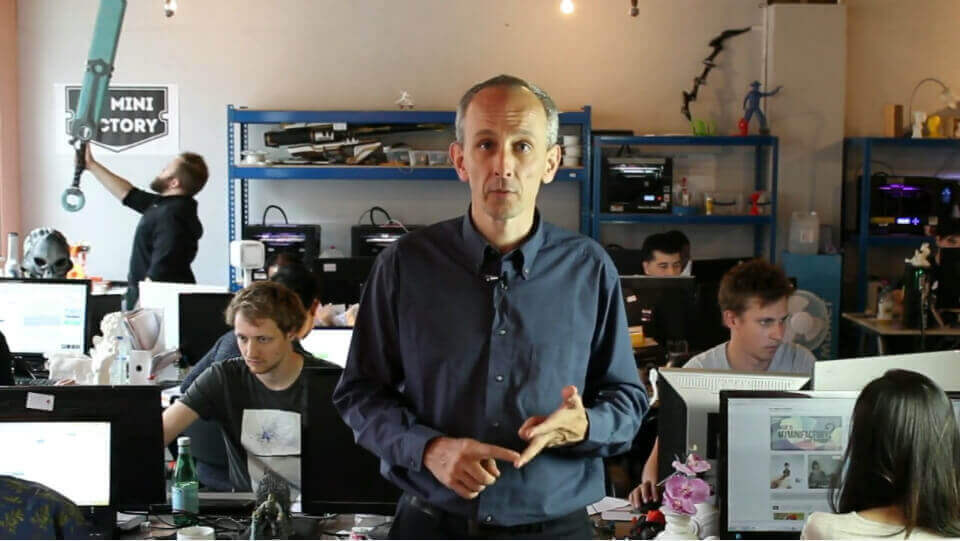All3DP interviews Sylvain Preumont, founder and executive chairman of MyMiniFactory, about his vision of an open future for 3D printing.
This striking tableau is found on a large banner hanging on one of the walls at MyMiniFactory‘s London headquarters; it was a gift from Bungie, makers of the video game juggernauts Halo and Destiny, following a collaboration at a recent trade show.
Sylvain Preumont’s venture isn’t entering the space race — at least, not yet — but from the degree of buzz and activity on the day that All3DP visits the MyMiniFactory offices, you’d be forgiven for thinking otherwise.
In fact, the company is celebrating the end of a highly successful campaign on Seedrs, the crowdfunding platform. MyMiniFactory hit its £500,000 investment target in its first two weeks, eventually closing at £781,411, or 156% of the original goal.
“3d printing is really exciting,” says Preumont, the company’s executive chairman. “It’s a no-brainer that it will completely change the future. The one questions that remains is ‘when?'”
As the founder and CEO of iMakr, a bricks-and-mortar retailer with storefronts in New York City and London, Preumont’s name is already known quantity in the realm of 3D printing. But while iMakr is concerned with the hardware that facilitates a 3D print, MyMiniFactory is an online community for the creative minds that use these tools — and one that can adapt to the evolving face of the industry.
“You don’t know which technology will make it, you don’t know which manufacturer will make it, but you know for sure that you will have a big need for 3D printable files,” explains Preumont. “That is our business. We connect people with files — creative files, beautiful files, nobles files — that are ready for printing.”
MyMiniFactory Community is Growing
In the two years since it was founded, MyMiniFactory has gradually built a community of some 100,000 users who share and discuss their 3D print designs via a searchable database. This is a model that we’ve seen elsewhere, but two factors set MyMiniFactory apart from its competitors.
The first is an emphasis on curation; every file that is submitted to the site is printed and tested by staff to check that it meets a certain standard.
“For the market to grow, one thing that is needed is quality,” explains Preumont. “There are so many reasons for a print to fail, so you really want to make sure it’s not due to the files.
“It can be on the machine, it can be on the filament, it can be on yourself, it can be on the power plug, whatever — not on the files. We want to offer quality and reassurance, through the best possible files.”
The second tenet of MyMiniFactory is openness, both in terms of its approach to technology and to the remit of the site’s designs. While the site often compares itself to YouTube in terms of the space it wants to eventually occupy, Preumont uses other social platforms to explain his company’s strategy — specifically, the way Myspace was killed off by Facebook.
“Myspace missed , and they should have won,” he says. “They were the one, they were there. Right time, right people, right technology.
“They had enough money to do anything, they weren’t limited by anything — except by one thing. They were closed, closed to one limited strategy which was successful, but prevented them from seeing the big picture.”
Where Myspace became a platform that was primarily for artists, Facebook posited itself as a platform that anyone — and everyone — could use.
This is where MyMiniFactory’s curation comes into play, supporting the kinds of projects that gain a natural momentum of their own, but also shining a spotlight on those that could use more exposure.
“We want to be open to everything, and that takes a bit more effort on our part. We want to push the that are successful, and we need to make that happen, but we also want to keep an eye on the rest.”
Pursuing New Technologies
And while Preumont is understandably reluctant to discuss his competitors too directly, he believes that MyMiniFactory’s independence gives it a crucial edge. After all, communities that are tied to specific printers or manufacturers (like Makerbot’s Thingiverse) are shutting themselves off from the potential of new technologies — the high resolution of resin-based printers, for example.
Preumont himself is clearly thrilled by the possibilities that 3D printing has to offer, and his infectious enthusiasm extends to the processes that are yet to become everyday — as well as those that are yet to surface at all.
“Obviously today FDM technology is quite successful, but honestly resin-based technology is very promising as well, if it comes down in price and becomes a bit more affordable. It’s still a bit messy, but it might change, it might improve. You never know!
“Sintering is also extremely exciting, though it’s still a bit too expensive. And metal… when will we be able to tinker with metal 3D printing at home? We don’t know, but we know that we will — there’s no reason that we wouldn’t. But it will take time.”
Of course, it will also take time to see what MyMiniFactory’s future will actually look like.
In the short term, Preumont says that the funds from the Seedrs campaign will simply enable the company to continue what it’s been doing for the past two years (“I’m not going to go out and by myself a Tesla car!”). Beyond that, we’ll have to wait to see if MyMiniFactory’s open philosophy can match the clear potential of Preumont’s vision.
But if nothing else, the Seedrs campaign should be seen as a massive vote of confidence from investors.
License: The text of "The Open Future of 3D printing: Big Ideas at MyMiniFactory" by All3DP is licensed under a Creative Commons Attribution 4.0 International License.


